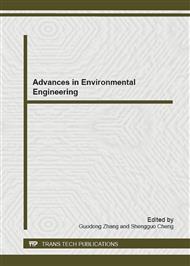p.496
p.501
p.505
p.510
p.516
p.521
p.525
p.529
p.533
The Study on Experiments of Oilfield Wastewater Treatment by Microwave-Assisted Demulsification
Abstract:
Oily wastewater from oil field by microwave induced and catalytic demulsification was studied in this paper. The advantages and prospects of the microwave technology was analyzed. Microwave treatment of oilfield wastewater has advantages such as equipment occupies a small space, easy to operate, portable, easy to transport, easy to installation and commissioning, short reaction time, high efficiency, discharge water which has good quality, temperature and other factors do not affect the treatment oilfield wastewater effect and so on. Microwave also has a bactericidal effect which was applicable to treat oilfield wastewater in both South and North of China. When the processing time is 2.5 min at temperature 57°C, microwave demulsification has the best effect. Based on the research of microwave demulsifucation mechanism, a conclusion is reached that microwave heating effect and microwave catalytic eddect play a leading role on the demulsification.
Info:
Periodical:
Pages:
516-520
Citation:
Online since:
November 2012
Authors:
Keywords:
Price:
Сopyright:
© 2012 Trans Tech Publications Ltd. All Rights Reserved
Share:
Citation:


